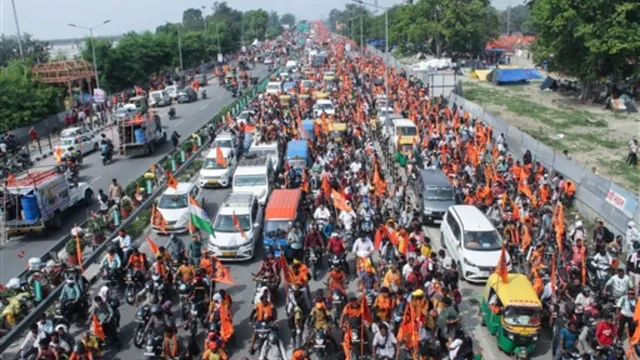New Delhi:
As the Kanwar Yatra reaches its final phase, Delhi has come to a near standstill with major traffic disruptions reported since July 20. The city’s roads have been paralysed under the weight of an unprecedented surge in kanwariyas—devotees of Lord Shiva—who are undertaking the annual pilgrimage to collect holy water from the Ganges.
Despite the Delhi Traffic Police deploying over 1,000 personnel and issuing several advisories, congestion has intensified over the past four days. The situation worsened particularly from July 21, forcing the closure of key stretches such as the Agra Canal Road, which links Noida and Faridabad via Kalindi Kunj-Yamuna Bridge, and seven other routes near the Apsara border in northeast Delhi.
Commuters have faced major delays across key arterial roads including the GT Road, Wazirabad Road, Delhi-Meerut Expressway, National Highway-9, DND Flyway, Vikas Marg, Ring Road, Outer Ring Road, and Mathura Road. Even stretches in east and south Delhi witnessed heavy gridlock, with processions of kanwariyas on foot and in vehicles dominating the lanes. Many were seen travelling in trucks and SUVs outfitted with loudspeakers, disco lights, and boom boxes—often breaching designated lanes and noise pollution norms.
Although the police had demarcated dedicated lanes using ropes and barricades, reports suggest that enforcement remained weak. In several cases, kanwariyas crossed into general traffic areas or passed freely through residential neighbourhoods. Motorists said police personnel appeared reluctant to intervene.
“The enforcement has been largely symbolic,” said Atmprakash Shrivastava, a 41-year-old civil engineer. “It now takes me nearly two hours to reach central Delhi from Ghaziabad via the Bhopura border. Police are present but seem helpless in front of large groups of kanwariyas.”
According to officials, the Kanwar Yatra, which began on July 11, saw a significant rise in participants this year. In response, the police ramped up personnel deployment and issued three additional traffic advisories from July 21 to July 23. However, daily commuters and residents argue that the advisories were not matched by effective ground action.
Chitra Jain, president of the Ashoka Park RWA in New Friends Colony, described the traffic and noise levels around CV Raman Marg as “chaotic,” especially during night hours. “Loud music from nearby camps has made life miserable for senior citizens and children. The administration must rethink the route planning and ensure pilgrims use peripheral roads instead of entering city limits,” she said.
Residents also reported that many of the 374 Kanwar camps—132 more than last year—spilled onto main roads, reducing three-lane stretches to single-lane bottlenecks. In places like Najafgarh Road, Rohtak Road, and Mathura Road, public transport vehicles like e-rickshaws and autos were forced to detour through narrow residential lanes to avoid jams.
Local businessman Sushil Saini, 57, observed a lack of enforcement at these camps. “Motorcycles were parked haphazardly, loudspeakers violated noise limits, and trucks blocked roads. Police officers were present but mostly filmed the scenes on their phones instead of acting.”
In response to public criticism, Additional Commissioner of Police (Traffic) Dinesh Kumar Gupta stated that the volume of kanwariyas was beyond initial expectations. “We’ve increased deployment and closed some major stretches as a preventive measure. Our priority remains to facilitate the safe passage of kanwariyas while minimising disruption to the public.”
Nevertheless, the chaos of the past few days has reignited debates around the city’s preparedness for large-scale religious events. Many residents and traffic experts are calling for a more robust, long-term traffic management plan for future yatras, including better route separation, real-time enforcement, and use of outer ring roads and expressways for pilgrim transit.
With the Kanwar Yatra concluding on Wednesday, Delhiites are hoping for a swift return to normalcy—but for many, the memory of days spent in traffic will linger long after the last kanwariya departs.








